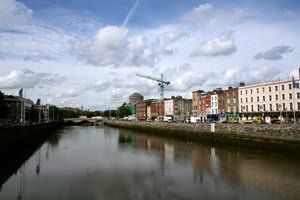 Ireland is a legal country with a republican form of government. It refers to the parliamentary republics. The law is based on the Constitution of the country which was adopted in 1937. The Head of State is the President. His powers are however limited. The President is elected for a term of seven years by direct vote. According to the current Constitution of Ireland, a President is only allowed to serve for no more than two consecutive terms. As a rule, representatives of various opposing parties are fighting for the presidency. However, after the candidate is elected, he is obliged to leave all his party beliefs and interests aside and engage in unbiased work in order to benefit his State.
Ireland is a legal country with a republican form of government. It refers to the parliamentary republics. The law is based on the Constitution of the country which was adopted in 1937. The Head of State is the President. His powers are however limited. The President is elected for a term of seven years by direct vote. According to the current Constitution of Ireland, a President is only allowed to serve for no more than two consecutive terms. As a rule, representatives of various opposing parties are fighting for the presidency. However, after the candidate is elected, he is obliged to leave all his party beliefs and interests aside and engage in unbiased work in order to benefit his State.
The transport infrastructure in Ireland is well developed with the roads and railways both in perfect condition. It is also mandatory here that public …
Read further
Read further
Two languages have been officially approved in Ireland: English and Gaelic. The second language is often referred to as Celtic. It is in its …
Read further
Read further
 The administrative division in Ireland is unique as it was influenced by historical factors. In general, the country is divided into only four provinces. They in turn, are divided into counties (there are 32 in all). Due to the fact that Ireland is considered a unitary state, local government in the counties operates in accordance with the powers vested in it by the Parliament. The main tasks of local officials are to maintain the city infrastructure, organize safe road traffic, and provide all residents of the areas with services. Also, local self-government bodies deal with issues of environmental protection, matters related to the further development of the city and the planning of new structures and communications, and the organization of entertainment for major state or small domestic holidays. Usually, all funding is received by each local government directly from the central government. Some revenues for the local budgets are also generated from taxes and other related services.
The administrative division in Ireland is unique as it was influenced by historical factors. In general, the country is divided into only four provinces. They in turn, are divided into counties (there are 32 in all). Due to the fact that Ireland is considered a unitary state, local government in the counties operates in accordance with the powers vested in it by the Parliament. The main tasks of local officials are to maintain the city infrastructure, organize safe road traffic, and provide all residents of the areas with services. Also, local self-government bodies deal with issues of environmental protection, matters related to the further development of the city and the planning of new structures and communications, and the organization of entertainment for major state or small domestic holidays. Usually, all funding is received by each local government directly from the central government. Some revenues for the local budgets are also generated from taxes and other related services.
The economy of the Republic of Ireland over the past twenty years is gradually gaining momentum. The economic system largely depends on trade. Several …
Read further
Read further
 It is worth noting that because of its global beliefs, Ireland did not become a member of NATO and is pursuing an impressive policy of military neutrality. Despite this, the armed forces have been participating in the United Nations’ exercises for more than half a century. It is worth noting that the regular armed forces of Ireland are comprised of about thirteen thousand personnel. They consist of land, naval and air force units. There is also a military reserve on the register, which consists of about seventeen thousand personnel. The call-up age in the country starts from 17 years and ends at 49 years, but then again, service in Ireland is voluntary. The Commander-in-chief of the armed forces of the country is the President of Ireland.
It is worth noting that because of its global beliefs, Ireland did not become a member of NATO and is pursuing an impressive policy of military neutrality. Despite this, the armed forces have been participating in the United Nations’ exercises for more than half a century. It is worth noting that the regular armed forces of Ireland are comprised of about thirteen thousand personnel. They consist of land, naval and air force units. There is also a military reserve on the register, which consists of about seventeen thousand personnel. The call-up age in the country starts from 17 years and ends at 49 years, but then again, service in Ireland is voluntary. The Commander-in-chief of the armed forces of the country is the President of Ireland. 


